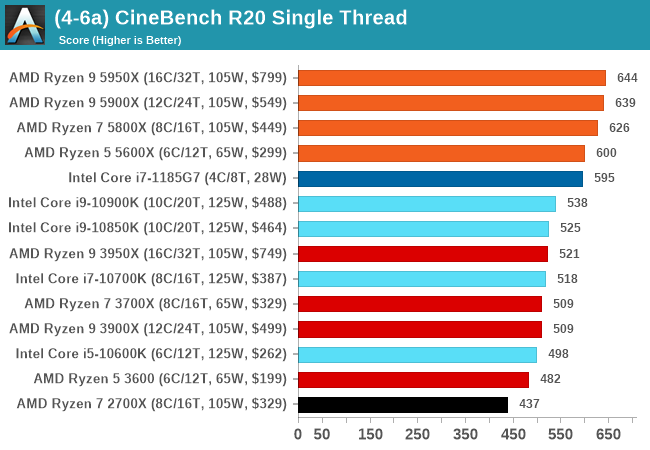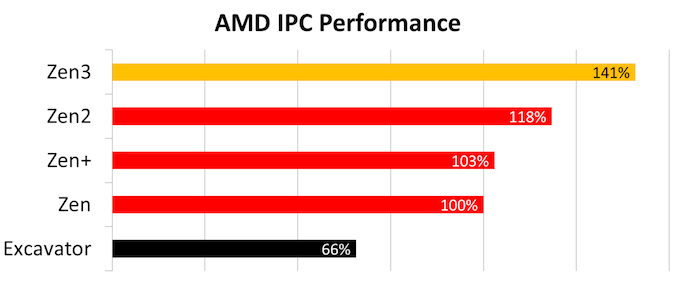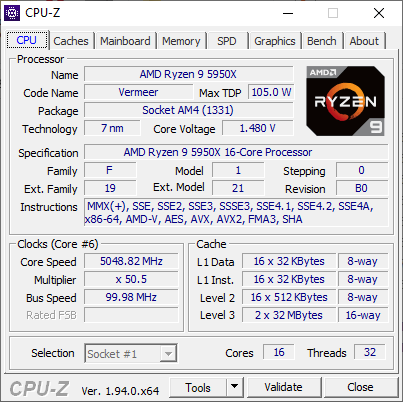AMD Zen 3 Ryzen Deep Dive Review: 5950X, 5900X, 5800X and 5600X Tested
by Dr. Ian Cutress on November 5, 2020 9:01 AM ESTConclusion: AMD Has Ryzen To The Top
Coming out the other end of this review, it’s hard to believe the extent to which some of AMD’s performance numbers have grown in the last five years. Even within the Ryzen family, we can pinpoint the leaps and bounds by which AMD is now the market leader in pure x86 performance.
Let’s start with some headline numbers.
+19% IPC Gain Confirmed
AMD quoted to us a raw IPC gain from Zen2 to Zen3 of +19%. AMD measured this with 25 workloads and both processors at 4.0 GHz, running DDR4-3600 memory. By comparison, we test with industry standard benchmarks at rated clock speeds and JEDEC supported memory, and we were able to accurately achieve that +19% number.
Compounding the generation-on-generation gains from a pre-Ryzen era, we’re seeing +114% IPC improvements, and if we look from the original Zen to Zen3, it is a ~41% gain.
In real world benchmarks, we saw an average +24% performance gain, showcasing both the increase in IPC and frequency uplift that the Ryzen 5000 parts have.
5.0 GHz Achieved on Ryzen
Turbo frequencies are often setup dependent, and because AMD uses a combination of listed turbo frequency and opportunistic boosting, the exact turbo frequency can be hard to nail down. For the top-tier Ryzen 9 5950X, AMD lists the turbo frequency as 4900 MHz for single core loading, however in very standard conditions, we were able to pass that to 5050 MHz. Diving deeper into the AGESA, this processor actually has a ‘maximum frequency’ setting of 5025 MHz. All of our Ryzen 5000 series processors offered +50-150 MHz above the listed turbo showcasing that these parts still have some headroom.
As we note in the review, AMD could have listed a 5 GHz turbo frequency, and it would be a big win for the company. However, I feel the company (a) wants to focus more on the market leading performance and engineering which doesn’t need 5 GHz, and (b) if they listed 5 GHz, it would suddenly be the only messaging people would take from the product launch. By not listing an explicit 5 GHz, it also allows AMD room to maneuver for a future product.
New WRs in Cinebench 1T, Breaking 10K in nT
AMD currently loves presenting CineBench as a measure of performance (Intel seems to flip/flop on the issue, depending on its position), and one of the main launch announcements was breaking the 600 point barrier in single threaded performance. At the time, it stated that the top three parts could get this value, whereas the Ryzen 5 5600X was just slightly behind.

In our testing, we scored at least 600 on all processors. This is significant as Intel’s latest Tiger Lake processors, turbo-ing at 4.8 GHz with as much power as they can use, only scored 595. Users that want a Tiger Lake can’t find one in a desktop, whereas the base Ryzen 5 5600X is $300.
Another win worth mentioning here though not explicitly announced by AMD is breaking the 10000 point barrier with the Ryzen 9 5950X in the multithreaded test. We achieved it just by the skin of our teeth, and a good few hundred points above AMD’s ‘reviewer guide’ that accompanies every launch. The only other CPUs to get above this value are 205 W Xeons or Threadrippers, while AMD does it within the 142 W peak power window.
Gaming: Cache is Good, But Depends on the Title
Performance in gaming is always a bit harder to pin down performance numbers, depending on the titles, resolutions, graphics card used, memory and drivers. AMD came into Zen3 showcasing a +5-50% gain at 1080p High over Zen2 across a number of titles, averaging 20-25%, along with performance leadership comparing against Intel’s best performer.
We don’t test at 1080p High, however we do have two metrics worth comparing. We run our games with an RTX 2080 Ti.
At the purely CPU-limited scenario, at the lowest resolutions and the lowest quality, we saw a +44% average uplift going from Zen2 to Zen3, from +10% on the low end to +80% on the high-end.
At 1080p Maximum, we saw a +10% average uplift going from Zen2 to Zen3. This varied from benchmarks where the results were equal due to being GPU-limited, to some modest +36% gains in more CPU-limited tests.
When we compare AMD against Intel, AMD easily wins the CPU-limited lowest resolution tests from +2% to +52%, averaging around +21% higher FPS. In the 1080p Maximum however, AMD and Intel trade blows, swaying from -4% to +6% for AMD (except in our Civ6 test, which is a +43% win for AMD).
As we saw in our recent Broadwell re-review, having access to large amounts of lower latency cache seems to be a good way to increasing gaming performance. By moving from each core having access to 16 MB to 32 MB, along with raw IPC gains, AMD is showing some good uplift. On the competitive front, we’re seeing a more even battlefield between Intel and AMD as the settings are cranked up.
Overall Impressions of Zen 3 and Ryzen 5000
One of the exciting things about probing a new core is finding out all the little quirks and improvements that they don’t tell you about. It’s been interesting finding out how this core was put together, both from our findings and discussions AMD’s engineers.
Moving to an 8-core CCX for this generation was a no-brainer, with an easy up-tick in performance. However it is the changes in the execution units and load/store were a lot of the magic happens – increasing to peak 3 loads/cycle and 2 stores/cycle, splitting out some of the ALU/AGU work, finer grained transitions from decoder/op-cache to the micro-op queue, and pre-fetchers with more bandwidth all help to that. A lot of the instruction improvements, such as lower latency FMA and faster DIV/IDIV is going to scale well as we move into the enterprise and EPYC processors.
With AMD taking the performance crown in almost area it’s competing in, attention now comes to price. Having $300 as an entry level for this tier is going to sting a lot of users who would rather spend $200 or less – despite AMD having nine out of ten of Amazon’s best sellers, only two of those parts are $300 and up. There’s going to be an early adopters tax as well – one could argue that moving into Q1, when AMD is enabling 400-series motherboards, might be a better inception point for a lot of users.
Having said that, with Intel set to launch Rocket Lake at the end of Q1 next year with 8 cores, this sub-$300 market is going to be ripe for any AMD Zen3 APU to come in and take that price bracket. AMD never launched Zen2 APUs into the consumer market, which might indicate a fast follow-on with Zen3. Watch this space – a monolithic Zen3 APU is going to be exciting.
| AMD Ryzen 5000 Series Processors Zen 3 Microarchitecture |
||||||
| AnandTech | Cores Threads |
Base Freq |
Turbo Freq |
L3 Cache |
TDP | MSRP |
| Ryzen 9 5950X | 16c/32t | 3400 | 4900 | 64 MB | 105 W | $799 |
| Ryzen 9 5900X | 12c/24t | 3700 | 4800 | 64 MB | 105 W | $549 |
| Ryzen 7 5800X | 8c/16t | 3800 | 4700 | 32 MB | 105 W | $449 |
| Ryzen 5 5600X | 6c/12t | 3700 | 4600 | 32 MB | 65 W | $299* |
All things considered, we’re really impressed with what AMD has achieved here. After the disillusionment of years of weaker generation-on-generation performance uplifts from the competition, AMD set a goal to beat the average ~7% IPC year-on-year gain. With +19% IPC on Zen3, Intel has no equal right now - not even Tiger Lake at 4.8 GHz - and has lost that single-threaded crown.
Zen3 gets a gold award. No question.













339 Comments
View All Comments
Luminar - Thursday, November 5, 2020 - link
Cache Rules Everything Around MeSIDtech - Thursday, November 5, 2020 - link
Hi Andrei,Excellent work. Do you know how this performance shapes up against the Cortex A77 ?
t.s - Friday, November 6, 2020 - link
Seconded. Want to know how the likes of ryzen 4 4350G or 5600 versus Cortex A77 or A78.Kangal - Saturday, November 7, 2020 - link
It's hard to say, because it really depends on the instruction/software as it is very situational. It also depends on the type of device it is powering, you can move up from Phones, to Thin Tablets, to Thick Laptops, to Large Desktops, and upto a Server. Each device offers different thermal constraints.The lower-thermal devices will favour the ARM chip, the mid-level will favour AMD, and the higher-thermal devices will favour Intel. That WAS the rule of thumb. In general, you could say Intel's SkyLake has the single-threaded performance crown, then AMD's Zen+ loses to it by a notable margin but beats it in multi-threaded tasks, and then going to an ARM Cortex A76 will have the lowest single-thread but the highest multi-threaded performance.
Now?
Well, there's the newly launched 2021 AMD Zen3 processor. And the upcoming 2021 ARM Cortex-X Overclocked Big-core using the new A78 microarchitecture. Lastly there's the 2022 Intel Rocket Lake yet to debut. So it's too early to tell, we can only make inferences.
Kangal - Saturday, November 7, 2020 - link
Here is my personal (yet amateur) take on the future 2020-2022 standpoints between the three racers. Firstly I'll explain what the different keywords and attributes mean(from most technical to most real-world implication)
Total efficiency: (think Full Server / Tractor) how much total calculations versus total power draw
Multi-threaded: (think Large Desktop / Truck) how much total calculations
Single-threaded: (think Thick Laptop / Car) how much priority calculations
IPC performance: (think Thin Tablet / Motorbike) how much priority calculations at desirable frequency/voltage/power-draw
*Emulating:
Having a "simple" ARM chip running "complex" x86 instructions. Such as running 32bit or 64bit OS X or Windows programs, via new techniques of emulation using a partial-hardware and hybrid-software solutions. I think the hit to efficiency will be around x3, instead of the expected x12 degradation.
So here are the lists (from most technical to most real-world implication)
Simple Code > Mixed code > Recommended Solution
Here's how they stack up when running identical new code (ie Modern Apps):
Total efficiency: ARM >>>> AMD >> Intel
Multi-threaded: ARM > AMD > Intel
Single-threaded: Intel = AMD > ARM
IPC performance: ARM >>> AMD > Intel
Now what about them running legacy code (ie x86 Program):
Efficiency + *emulating: AMD > Intel >> ARM
Multi + *emulating: AMD > Intel >> ARM
1n + *emulating: Intel = AMD >>> ARM
IPC + *emulating: AMD > Intel > ARM
My recommendation?
Full Server: 60% legacy 40% new code. This makes ARM the best option by a small margin.
Large Desktop: 80% legacy 20% new code. AMD is the best option with modest margin.
Thick Laptop: 70% legacy 30% new code. Intel is the best. AMD is very close (tied?) second.
Thin Tablet: 10% legacy 90% new code. ARM is the best option by huge margin.
Tomatotech - Monday, November 9, 2020 - link
Excellent post, but worth pointing out that *all* modern chips now emulate x86 and x64 code. They run a front end that takes x86 / x64 machine code then convert that into RISC code and that goes through various microcode and translation layers before being processed by the backend. That black box structure has allowed swapping out and optimising the back end for decades while maintaining code compatibility on the front end.So it’s not as simple to differentiate between the various chips as you make it out to be.
Gondalf - Sunday, November 8, 2020 - link
I don't know. Looking Spec results, we can say Anandtech is absolutely unable to set a Spec session correctly. From the review Zen 2 is slower per Ghz than old Skylake in integer, that is absolutely wrong in consumer cores (in server cores yes), even worse Ice Lake core is around fast as old Skylake per GHz.Basically this review is rushed and very likely they have set all AMD compiler flags on "fast" to do more contacts and a lot of hipe.
My God, for Anandtech Zen 3 is 35% faster in the global Spec values than Zen 2. Not even AMD worst marketing slide say this. We have Zen 4 here not Zen 3. Wait wait please.
A really crap review, the author need to go back to school about Spec.
Obviously the article do not say that 28W Tiger Lake is unable to run at 4.8Ghz for more than a couple of seconds, after this it throttes down, so the same Willow Cove core on a desktop Cpu could destroy Zen 3 without mercy on a CB session. Not to mention the far slower memory subsystem of a mobile cpu.
Basically looking at games results, Rocket Lake will eclipse this core forever. AMD have nothing of new in its hands, they need to wait Zen 4
Qasar - Sunday, November 8, 2020 - link
yea ok gondalf, trying to find ways that your beloved intel doesnt lose at everything now ??accept it, amd is faster then intel across the board.
Spunjji - Monday, November 9, 2020 - link
That's a strange claim about Tiger Lake performance, Gondalf, because I seem to recall Intel seeding all the reviewers with a laptop that could run TGL at 4.8Ghz boost 'til the cows come home - and that's what Anandtech used to get that number. It's literally the best they can do right now. You're right of course - in actual shipping ultrabooks, TGL is a hot PoS that cannot maintain its boost clocks. Maybe by 2022 they'll finally put Willow Cove into a shipping desktop CPU."Basically looking at games results, Rocket Lake will eclipse this core forever"
If by "eclipse" you mean gain a maximum 5% advantage at higher clock speeds and nearly double the power draw then sure, "eclipse", yeah. 🤭
I love your posts here. Please, never stop stepping on rakes like Sideshow Bob.
macroboy - Saturday, December 12, 2020 - link
LOL look at AMD's Efficiency and sustained core clocks, Intel runs too hot to stay at 5ghz for very long. meanwhile Zen3 plows along at 55C no problem, *you're the one who needs to check your facts.